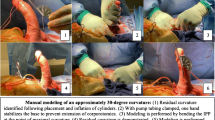Abstract
Purpose:To evaluate the results of plaque incision and venous patch grafting to correct the dorsal curvature associated with Peyronie's disease.Materials and methods:18 patients with Peyronie's disease were treated surgically. All of the patients have dorsal penile curvature for more than one year causing intromission impossible or with some difficulty because of curvature. Median penile angulatio was 60° (range 45°–75°). A transverse incision about 2 cm long was made on the plaque where maximal site of curvature was identified. The saphenous vein harvested from the ankle region is opened longitudinally and its endothelial surface is placed and sutured in contact with the tunical defect.Results:Complete penile straightening was achieved in 16 (88.8%) cases and only two patients have residual curvature less than 30° permitting sexual intercourse. None of the patients returned to baseline preoperative angulation state in the follow up period. 3 patients (16.6%) reported penile shortening, but only one was concerned and showed dissatisfaction about it. 6 patients (33.3%) have transient changes in penile sensation that resolved within 4 months.Conclusions:Plaque incision and placement of saphenous vein patch graft offers a 94.4% satisfactory result in Peyronie's disease causing penile dorsal curvature.
Similar content being viewed by others
References
Arena F, Peracchia G, Disteloma A et al. Peyronie's disease – incision and dorsal vein grafting combined with contralateral plication in straight terms the penis. Scand J Urol Nephrol 1999; 33: 181.
Brock G, Hsu GL, Nunes L et al. The anatomy of the tunica albuginea in the normal penis and Peyronie's disease. J Urol 1997; 157: 276.
Brock G, Kadıoglu A, Lue TF. Peyronie's disease: A modified treatment. Urology 1998; 42: 300.
El-Sakka A, Rashwan HM, Lue TF. Venous patch graft for Peyronie's disease, Part II: Outcome analysis. J Urol 1998; 160: 2053.
Jordan GH, Angermeier KW. Preoperative evaluation of erectile function with dynamic infusion cavernosometry/cavernosography in patients undergoing surgery for Peyronie's disease: Correlation with postoperative results. J Urol 1993; 150: 1138.
Kadioğlu A, Tefekli A, Erol H et al. Color doppler assessment of penile vascular system in men with Peyronie's disease. Int J Impot Res 2000; 12: 263.
Lopez JA, Jurow JP. Penile vascular evaluation of men with Peyronie's disease. J Urol 1993; 149: 53.
Lue TF, El-Sakka A. Venous patch graft for Peyroniase, Part I. Technique J Urol 1998; 160: 2047.
Montorsi F, Salonia A, Maga T et al. Evidence based assessment of long term results of the plaque incision and vein grafting for Peyronie's disease. J Urol 2000; 163: 1704.
Perovic SV, Djordjevic MIJ. The penile disassembly technique in the surgical treatment of Peyronie's disease. BJU Int 2001; 88: 731.
Tunoguntla HSGR. Management of Peyronie's disease – a review. World J Urol 2001; 19: 244.
Author information
Authors and Affiliations
Rights and permissions
About this article
Cite this article
Metin, A., Kayigil, Ö. & Ahmed, S.İ. Plaque incision and venous patch grafting for Peyronie's disease. Int Urol Nephrol 34, 223–227 (2002). https://doi.org/10.1023/A:1023290705439
Issue Date:
DOI: https://doi.org/10.1023/A:1023290705439




